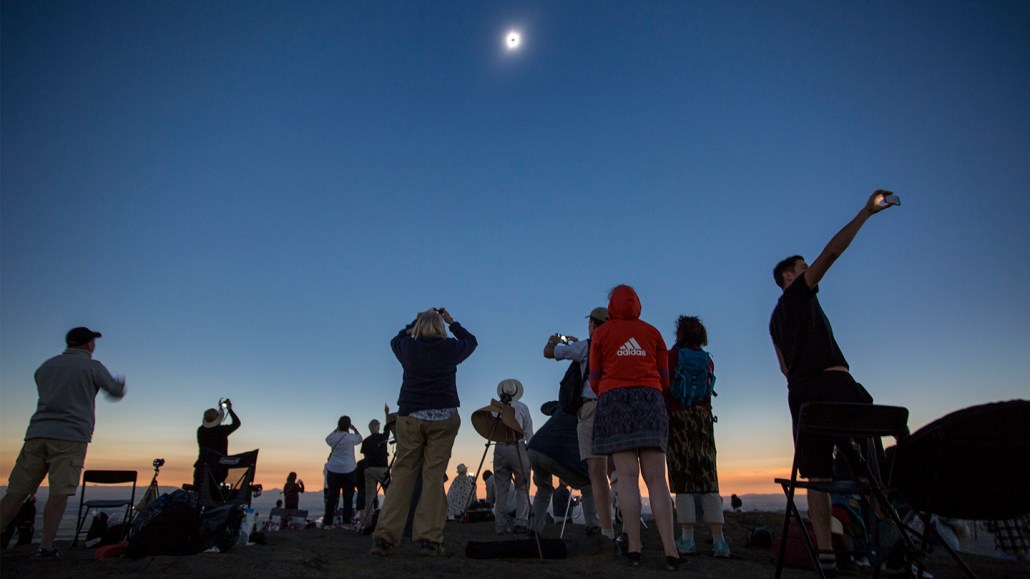
Eclipse watchers, like these people in Menan, Idaho, who saw the August 21, 2017, eclipse, may notice that colors of objects around them look different when the moon completely blocks the sun.
Natalie Behring/Getty Images
During a total solar eclipse, people may see some strange things. Sure, there’s the main event happening in the sky (SN: 1/4/24). But the world may also look a little different on the ground.
For a few minutes, as the moon blocks the sun’s rays, colors fade to silvery gray in the false twilight. Usually vibrant reds may appear dark or even black, while blues and greens will pop.
Two things are happening to produce the color shift, says Takeshi Yoshimatsu, a color vision researcher at Washington University School of Medicine in St. Louis.
First, there’s what is going on in the atmosphere.
Sunlight is made up of light waves with a broad spectrum of colors. On a normal sunny day, particles and water droplets in the air scatter sunlight as it passes through the atmosphere. Sunlight’s blue light waves scatter more than its red waves do, because blue waves have shorter wavelengths. Scattered blue waves paint the sky blue. Meanwhile, sunlight’s red waves are more likely to reach the ground.
An object’s color depends on the light it reflects. Because more red light tends to reach the ground in direct sunlight, sunbathed objects reflect more red light than blue. That makes reds appear brighter, Yoshimatsu says.
During a total solar eclipse, the moon blocks the sun, so most of the light hitting and reflecting off objects on the ground is indirect light. More of that indirect light is easily scattered blue waves, so objects reflect more blue light. That causes an apparent shift in the color spectrum toward blue, Yoshimatsu says. Something similar happens in other dim-light conditions, like sunset.
Then there’s what is happening in our eyes.
In bright light, light-gathering cells in the retina called cones provide color vision. The majority of cones are tuned to detect red or green, with a small percentage devoted to blue. The three together produce red-green-blue color vision. With fully active cones, reds usually appear brighter than blues during daylight.
In the dark, very sensitive light-gathering rod cells responsible for night vision take over. But there’s only one type of rod, so people don’t see colors in dark or very low-light conditions.
An eclipse, dusk, dawn or other low-light conditions are “somewhere in between,” Yoshimatsu says, “not quite bright, but not quite dark. That’s where the Purkinje effect comes in.”
The effect — also called the Purkinje shift or Purkinje phenomenon — is the tendency for the eye’s sensitivity to luminance to shift from red to blue in low light.
Under certain low-light conditions, both rods and cones contribute to our vision, says Rafal Mantiuk, a computer and vision scientist at the University of Cambridge. Cones aren’t sensitive enough to pick up dim light, so even though the cells are still working at twilight, colors fade and the contrast between them becomes smaller, Mantiuk says. Meanwhile, rods make a pigment that picks up blue and green wavelengths, making those colors appear brighter while reds seem darker. That happens only when cones are still active too.
“How exactly it works, the papers still argue and differ,” Mantiuk says.
He offers an important eclipse-watching tip, though. “Only people wearing [eclipse] glasses will be able to notice” the Purkinje shift. “If you’re not wearing glasses, it won’t be dark enough.”
Plus, eclipse glasses help protect against harmful rays from the sun, allowing people to view the event safely. The American Astronomical Society has a list of places providing safe eclipse glasses. And JAMA recently published tips for safe viewing and what to do if your vision is damaged while watching the eclipse.
This color effect won’t be visible in pictures, Mantiuk says. It’s a matter of perception, not just optics, so it has to be experienced in person. For those who want to see the Purkinje effect in action but aren’t in the path of totality, Mantiuk offers an experiment. Take a square of red cloth and one of blue and look at them in the light. Then dim the lights, maybe put on a pair of sunglasses and look again. The brightness of the squares should be reversed.






